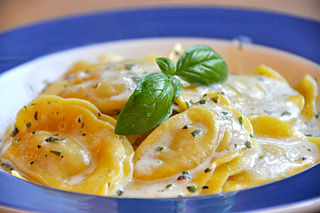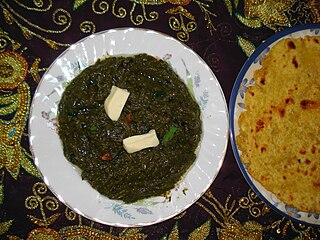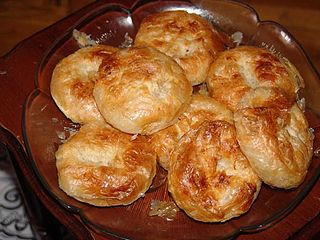Related Research Articles

Gnocchi are a varied family of dumplings in Italian cuisine. They are made of small lumps of dough, such as those composed of a simple combination of wheat flour, potato, egg, and salt. Variations of the dish supplement the simple recipe with flavour additives, such as semolina flour, cheese, breadcrumbs, cornmeal or similar ingredients, and possibly including herbs, vegetables, and other ingredients. Base ingredients may be substituted with alternatives such as sweet potatoes for potatoes or rice flour for wheat flour. Such variations are often considered to be non-traditional.

Lasagna, also known as lasagne, is a type of pasta, possibly one of the oldest types, made in very wide, flat sheets. The same-named Italian dish is made of stacked layers of lasagna alternating with fillings such as ragù, béchamel sauce, vegetables, cheeses, and seasonings and spices. The dish may be topped with grated cheese, which becomes melted during baking. Typically cooked pasta is assembled with the other ingredients and then baked in an oven. The resulting baked pasta is cut into single-serving square or rectangular portions.

Cornmeal is a meal ground from dried corn (maize). It is a common staple food and is ground to coarse, medium, and fine consistencies, but it is not as fine as wheat flour can be. In Mexico and Louisiana, very finely ground cornmeal is referred to as corn flour. When fine cornmeal is made from maize that has been soaked in an alkaline solution, e.g., limewater, it is called masa harina, which is used for making arepas, tamales, and tortillas. Boiled cornmeal is called polenta in Italy and is also a traditional dish and bread substitute in Romania.

Ravioli are a type of stuffed pasta comprising a filling enveloped in thin pasta dough. Usually served in broth or with a sauce, they originated as a traditional food in Italian cuisine. Ravioli are commonly square, though other forms are also used, including circular and semi-circular (mezzelune).

Saag, also spelled sag or saga, is an Indian subcontinental leafy vegetable dish eaten with bread, such as roti or naan, or in some regions with rice. Saag can be made from mustard greens, collard greens, basella or finely chopped broccoli along with added spices and sometimes other ingredients, such as chhena.

Risotto is an Italian rice dish cooked with broth until it reaches a creamy consistency. The broth can be derived from meat, fish, or vegetables. Many types of risotto contain butter, onion, white wine, and Parmesan cheese. It is one of the most common ways of cooking rice in Italy. Saffron was originally used for flavour and its signature yellow colour.

Green sauce or greensauce is a family of cold, uncooked sauces based on chopped herbs, including the Spanish and Italian salsa verde, the French sauce verte, the German grüne Soße or Frankfurter grie Soß, the British mint sauce and greensauce, and the Argentinian chimichurri.

Kugel is a baked casserole, most commonly made from lokshen or potato. It is a traditional Ashkenazi Jewish dish, often served on Shabbos and Jewish holidays. American Jews also serve it for Thanksgiving dinner.

Börek or burek is a family of pastries or pies found in the Balkans, Turkey, Armenia, Levant, Northern Africa and Central Asia. The pastry is made of a thin flaky dough such as filo with a variety of fillings, such as meat, cheese, spinach, or potatoes. A borek may be prepared in a large pan and cut into portions after baking, or as individual pastries. They are usually baked but some varieties can be fried. Borek is sometimes sprinkled with sesame or nigella seeds, and it can be served hot or cold.

A buñuelo (Spanish:[buˈɲwelo], alternatively called boñuelo, bimuelo, birmuelo, bermuelo, bumuelo, burmuelo, or bonuelo, is a fried dough fritter found in Spain, Latin America, and other regions with a historical connection to Spaniards, including Southwest Europe, the Balkans, Anatolia, and other parts of Asia and North Africa. Buñuelos are traditionally prepared at Christmas. It will usually have a filling or a topping. In Mexican cuisine, it is often served with a syrup made with piloncillo.

Gratin is a culinary technique in which a dish is topped with a browned crust, often using breadcrumbs, grated cheese, egg or butter. The term may be applied to any dish made using this method. Gratin is usually prepared in a shallow dish of some kind. A gratin is baked or cooked under an overhead grill or broiler to form a golden crust on top and is often served in its baking dish.

Spinach salad is a salad with spinach as its main ingredient. In the US, a version dressed in a hot bacon dressing which slightly wilts the spinach was popular in the 1970s and into the 1980s and has been called the classic version.

Shakshouka is a Maghrebi dish of eggs poached in a sauce of tomatoes, olive oil, peppers, onion, and garlic, commonly spiced with cumin, paprika and cayenne pepper. Shakshouka is a popular dish throughout North Africa and the Middle East.

Afghan cuisine is influenced by Persian, Central Asian, and Indian cuisines due to Afghanistan's close proximity and cultural ties. The cuisine is halal and mainly based on mutton, beef, poultry and fish with rice and Afghan bread. Accompanying these are common vegetables and dairy products, such as milk, yogurt, whey, and fresh and dried fruits such as apples, apricots, grapes, bananas, oranges, plums, pomegranates, sweet melons, and raisins. The diet of most Afghans revolves around rice-based dishes, while various forms of naan are consumed with most meals. Tea is generally consumed daily in large quantities, and is a major part of hospitality. The culinary specialties reflect the nation's ethnic and geographic diversity. The national dish of Afghanistan is Kabuli palaw, a rice dish cooked with raisins, carrots, nuts, and lamb or beef.

Sephardic Jewish cuisine, belonging to the Sephardic Jews—descendants of the Jewish population of the Iberian Peninsula until their expulsion in 1492—encompassing traditional dishes developed as they resettled in the Ottoman Empire, North Africa, and the Mediterranean, including Jewish communities in Turkey, Greece, Bulgaria, North Macedonia, and Syria, as well as the Sephardic community in the Land of Israel. It may also refer to the culinary traditions of the Western Sephardim, who settled in Holland, England, and from these places elsewhere. The cuisine of Jerusalem, in particular, is considered predominantly Sephardic.

Urap is a salad dish of steamed vegetables mixed with seasoned and spiced grated coconut for dressing. It is commonly found in Indonesian cuisine, more precisely Javanese cuisine. Urap can be consumed on its own as a salad for vegetarian meals or as a side dish. Urap is usually found as a prerequisite side dish of Javanese tumpeng, a cone-shaped rice mound surrounded with assorted dishes, as well as part of a nasi kuning dish. In Balinese cuisine, it is known as Urab sayur.

Gnudi, also called malfatti, are gnocchi-like dumplings made with ricotta cheese and semolina instead of potato flour. The result is often a lighter, "pillowy" dish, unlike the often denser, chewier gnocchi. Gnudi is the Tuscan word for "naked", the idea being that these "pillowy" balls of ricotta and spinach are "nude ravioli", consisting of just the tasty filling without the pasta shell.

Sai bhaji is a Sindhi vegetarian curry, consisting of dal (lentils), palak (spinach) and other vegetables. It forms a staple part of the local cuisine and is considered a rich source of nutrition due to its mix of various greens.

Matzo lasagna, also known as matzagna, is a Jewish type of lasagna made by layering sheets of matzo with typically a tomato or a bechamel sauce and various cheeses. It originated from the Italian Jews and is popular in Israel, the United States, and the rest of the diaspora. It is similar to the traditional Sephardic Jewish dish mina; though the fillings differ as mina is typically made with meat or a spinach and feta filling while matzo lasagna is made with sauce and cheese.
Lokshen mit kaese, (Yiddish: לאָקשן מיט קעז lokshn mit kez), also known as (Hebrew: איטריות וגבינה itriyot v’gvina), Jewish mac and cheese, lokshen with cheese, or Jewish egg noodles with cottage cheese, is an Ashkenazi Jewish dish popular in the Jewish diaspora particularly in the United States, consisting of lokshen, or Jewish egg noodles that are served with a cheese sauce typically made with cottage cheese and black pepper, and sometimes farmers cheese may be used in place of the cottage cheese, and sour cream, butter, caramelized onions, garlic, tomatoes, mint, currants, parmesan, and other ingredients may be added. Sometimes a sweet variety is made with cinnamon sugar. It has been compared to a deconstructed noodle kugel and is considered by many to be a Jewish comfort food.
References
- ↑ Wright, Clifford A. (2011). The Best Soups in the World. Houghton Mifflin Harcourt. ISBN 9780544177796.
- ↑ Cohen, Jayne (2008). Jewish Holiday Cooking. Wiley.
- ↑ Goldstein, Joyce (12 April 2016). The New Mediterranean Jewish Table: Old World Recipes for the Modern Home. Illustrated by Hugh D'Andrade. (1st, ebook ed.). Oakland: University of California Press. p. 203. ISBN 978-0-520-96061-9. LCCN 2020757338. OL 27204905M. Wikidata Q114657881.